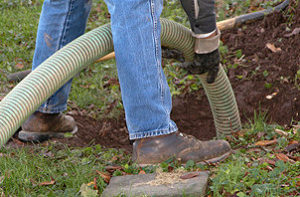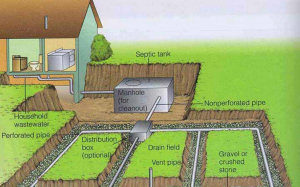Septic Tank Pumping and Grease Trap Cleaning
Keeping Central Texas Flowing
The Simpson Septic Pumping motto is “Keeping Central Texas Flowing” and we take it seriously – especially on our household septic tank pumping jobs and commercial grease trap cleanings for the Austin and Bastrop areas. We understand scheduling septic tank pumping, especially during an emergency, can be a hassle. From our friendly customer service to our expert technicians, every member of our team is trained to make your septic tank pumping and grease trap cleaning hassle free. We have a range of services to keep your system flowing smoothly, from pumping out the tank to applying grease trap additives and treatments to running new field lines.
A Cleaner Approach to Home Septic Tank Pumping
When Simpson Septic Pumping comes to your home, we bring all our own septic pumping equipment. We clean your tank thoroughly, removing build-up on the septic tank baffles and septic system surfaces. Every hose is cleared and capped before it’s rolled back up, to ensure no residual sewage spills into your yard. This cleaner approach reflects our higher standard of septic service – and keeps your house and yard clean.
Simpson Septic Pumping Inspection
A home septic system inspection can help identify problems before they lead to costly septic repairs – or even worse, a complete septic system failure. Our inspection evaluates how your system is working.
In addition to identifying your tank material and the size of your septic tank, Simpson Septic Pumping also ensures that all materials are up to TCEQ code. As part of the inspection, we also check the condition of all septic tank materials to uncover any potential of system failure.
- Condition of cleanout
- Tank access meets TCEQ code
- Tank lid properly sealed
- Proper slope of inlet line from house to tank
- Signs of sewage above normal level
- Signs of root infiltration
- Condition of tank
- Tank draining properly
- Condition of distribution box
- Pipes free of buildup
- Proper flow of sewage
How Often? Well that all depends
Keep in mind that your On-Site Sewage Facility is not a city sewer. But treat it right, feed it properly, and it will provide efficient service. While operating your OSSF, remember these dos and don’ts:
DO:
- Have your tank pumped and cleaned by a TCEQ registered sludge hauler, of which Simpson Septic Pumping is registered and received a high compliance rating from the TCEQ. Use this table to determine how often you should have your tank pumped and cleaned (figures in green represents average situations)
Household size (number of people)
750
9.1
4.2
2.6
1.8
1.3
1.0
0.7
0.6
0.4
1,000
12.4
5.9
3.7
2.6
2.0
1.5
1.2
1.0
0.8
1,250
15.6
7.5
4.8
3.4
2.6
2.0
1.7
1.4
1.2
1,500
18.9
9.1
5.9
4.2
3.3
2.6
2.1
1.8
1.5
1,750
22.1
10.7
6.9
5.0
3.9
3.1
2.6
2.2
1.9
2,000
25.4
12.4
8.1
5.9
4.5
3.7
3.1
2.6
2.2
2,250
28.6
14.0
9.1
6.7
5.2
4.2
3.5
3.0
2.6
2,500
31.9
15.6
10.2
7.5
5.9
4.8
4.0
3.5
3.0
Tank Size (gallons);
Duration (in years) Between Pumpings or Inspections
- Obtain information on conserving water from your water supplier.
- Check your toilet for leaks periodically. Add a water-based dye to the flush tank and see if the dye appears in your toilet within 10 minutes (without flushing the toilet).
DON’T:
- Build over any part of your on-site sewage disposal system. Examples of items not to construct over your system: driveways, barns, storage buildings, sidewalks, and patios.
- Add chemical additives or the so-called enzymes into your OSSF. Some of these additives may even be harmful to the tank’s operation.
- Use the toilet to dispose of cleaning tissues, cigarette butts, or other trash. This disposal practice will waste water and burden the treatment system with an undesirable load of solids.
- Drive or park vehicles over the OSSF.
Septic System Maintenance
Care for your System
A Cleaner Approach to Home Septic Tank Pumping for Austin, Bastrop and the Central Texas Homes
Remember, a septic system is a “living organism” that needs regular care. Waste material builds up in the tank and drain field, and must be removed periodically to keep your septic system running smoothly.
Cleaning the tank is also part of maintenance; to extract all the material from the tank, the scum layer must be broken up and the sludge layers stirred up into a liquid portion of the tank. With regular septic inspections and upkeep, your system will serve you and your household well for many years to come.
Grease Trap Services
When you need your grease trap or interceptor maintained, pumped and cleaned, Simpson Septic Pumping is ready to service your restaurant / food preparation business in the Austin and Bastrop area.
Grease Trap and Interceptor services include:
- Cleaning grease traps and interceptors
- Drain cleaning
- Grease trap repair and replacement
- Grease trap treatment with additives
- Emergency spill clean up
Grease Trap cleaning for Restaurants
Successful restaurants turn to Simpson Septic Pumping for our expert septic, and grease trap services. We are also equipped in the application of bacteria treatments that consume fats, oils and greases digesting them into water and carbon dioxide.
Grease Trap Cleaning
Grease interceptors, also known as grease traps, are very similar to septic tanks found in homes. Water that enters drains in fixtures like dish washers, floor drains, and kitchen and bathroom sinks all lead to your grease trap, where a baffle then separates the material that enters. Like scum in a septic tank, grease that enters the trap will settle at the top, while food scraps and other solids will settle at the bottom.
These systems work great to keep water flowing through the building while keeping grease and other solid wastes out of the disposal lines. It’s every businesses responsibility to ensure that they do their part to maintain and clean their traps. An overflow of grease from a grease trap could clog sewer lines and cause blockages, which can cause unsanitary water to back up into surrounding homes, businesses, and streets.

 Problems with septic systems and grease traps stink! Not only are the odors embarrassing, but ignoring the problem can ruin your yard and your home or restaurant plumbing. Simpson Septic Pumping responds quickly and efficiently, preventing further damage and future repairs.
Problems with septic systems and grease traps stink! Not only are the odors embarrassing, but ignoring the problem can ruin your yard and your home or restaurant plumbing. Simpson Septic Pumping responds quickly and efficiently, preventing further damage and future repairs. From small, quick fixes to larger-scale jobs, our courteous crew has years of experience dealing with all kinds of repairs and maintenance. We don’t settle for anything less than your total satisfaction. If you are in Austin, Bastrop or the central Texas area, call today and see what we can do for you.
From small, quick fixes to larger-scale jobs, our courteous crew has years of experience dealing with all kinds of repairs and maintenance. We don’t settle for anything less than your total satisfaction. If you are in Austin, Bastrop or the central Texas area, call today and see what we can do for you.



